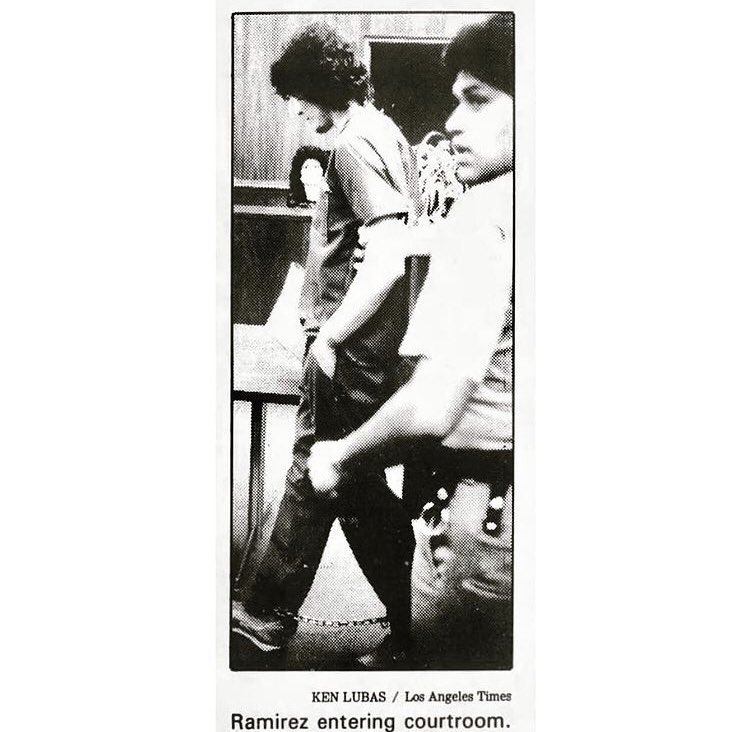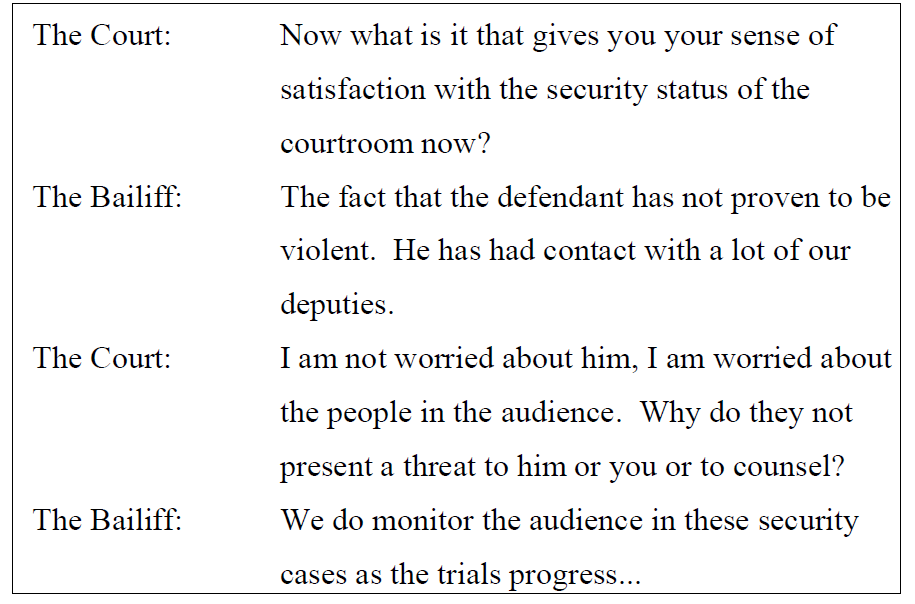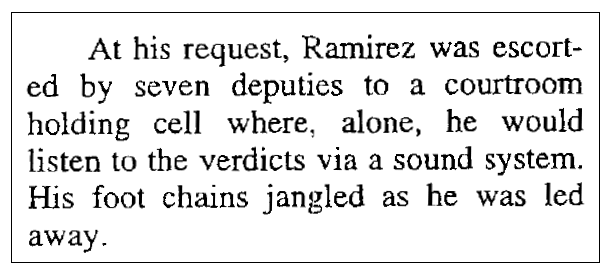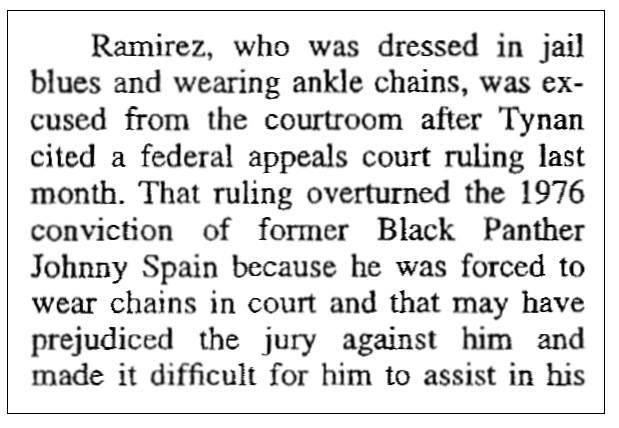
Richard Ramirez’s constitutional rights were violated on multiple occasions because he had waived his rights, due to being mentally incompetent and unable to understand what was happening – not because he was simple, but because his thoughts were disordered due to temporal lobe disorder.
Ramirez’s Habeas Corpus lawyers made 43 separate claims of a ‘Miscarriage of Justice.’ Claim 22 relates to the fact that Richard was unconstitutionally shackled throughout his capital trial and due to his inability to understand his rights, he agreed to being treated this way. But his agreement does not make it right – if his mental health assessments had not been suppressed or ignored, he would not have been given such a choice.
The unconstitutional use of restraints is not exclusive to the Ramirez case – this violation happens often, but for his trial in particular, the courts manufactured excuses for his leg chains, namely preposterous claims that Richard was somehow plotting to escape during the trial and kill the District Attorney, a fantasy that has probably crossed the mind of many a prisoner, but there was no proof he really said this and it is one in a long list of “confessions” that police failed to record.
The issue of Ramirez’s restraints had been ongoing since the 1986 Preliminary Hearing. While Richard was not present, the court changed its mind on what kind of shackles he should be wearing. Richard was originally required to wear only handcuffs, but they decided he must wear the ankle shackles instead. This decision was made because a marshal claimed that Richard had told him he wanted to escape (what prisoner doesn’t want to escape?), and planned to do so by attempting to steal the officer’s weapon. The court stated as follows:
“Based upon that, we have elected to proceed in this fashion. I am not welded (sic) to it. If things go well, we may change. It is also better for your client’s benefit to have a rather peaceful Marshal’s Corp.”
Federal Writ of Habeas Corpus pg. 577
Later, still in 1986, there was another discussion between all involved parties (again without Richard), regarding security in the courtroom. Richard’s trial counsel was worried as they had received death threats (when the public is so hyped up against a defendant, they stop believing in natural justice, apparently), so the court brought in a law enforcement ‘sergeant’ to discuss security. The court metal detector had failed, which required hand searching, but they decided not to conduct searches, nor did they bother to replace the metal detector. For such a high-profile case, minimal effort was being made.
The next part of the discussion involved Richard’s level of threat.

On 19th December 1988, facing jurors for the first time for the jury selection process, Ramirez was visibly restrained and yet another discussion took place on whether he should be wearing a leg brace or ankle chains. Halpin, who went on to prosecute Ramirez, pointed out that the defendant was wearing them and should not be – there was a legal precedent against it. He felt that they needed to address the issue once more, because the chains would be visible as the jurors entered past the counsel table.

Richard’s attorneys suggested that his restraints should be removed entirely. Halpin disagreed and suggested a leg brace, as it was less visible. However, Richard found the leg brace to be painful and the court accepted that the defendant should not be “uncomfortable and physically in pain” during the trial. However, because of some alleged threats, the court declared that Richard was too much of risk – the shackles must remain.
The court acknowledged that the restraints had been visible to the prospective jurors, so the defence attorneys suggested a solution – to place a curtain or barrier in front of the table so the chains would not be visible. The request seems to have been ignored – the court did not care about the defendant’s constitutional rights. Yet again, at a January 1989 hearing, Ramirez was visibly chained in front of the jury, and the court offered him the painful leg brace once more. Richard stated that he did not wish to wear any restraint but was told the sheriff feels they are necessary – no doubt because of baseless claims that Ramirez had made a threat.
The court took a ‘waiver’ – a supposed “willingness” from Richard to wear the shackles, despite his statement that he did not wish to. The Petition states this waiver was not valid – Richard was not advised of his constitutional right to refuse beforehand and so he proceeded in chains.
The visibility of restraints – or even prison attire – infers guilt on a psychological level. To see someone in shackles gives the impression of a wild and dangerous animal and encourages fear.
The court instructed the jury to ignore Richard’s shackles.
“You may have observed that the defendant has worn restraints while in the courtroom. This fact shall have no bearing upon your determination of the defendant’s guilt or innocence. That determination must be based solely upon the evidence presented to you.”
It was not good enough. Several of the jurors mentioned seeing them and had been led to believe that he was a danger to the court – on top of the crimes he was charged with. The following images are from their witness statements for his Habeas Corpus appeal. This is what they said, from Document 20-8.



Journalists in the press gallery also noticed and remarked upon them at all stages of the trial. From the Los Angeles Times, 1st May 1986, 21st September 1989 and 25th September 1989, from Documents 19-8 and 19-9.



It should be noted that, while far from a model citizen, Richard Ramirez had no history of violence before, or after the alleged crimes. This includes the time he was in the custody of the Texas Youth Council, and up until the point of the trial. Even during the span of the crimes, none of his associates witnessed Ramirez behaving in a violent or aggressive manner. He had no history of escape attempts or violence towards staff or guards in the courtroom. The petition states:
“prior to trial, the bailiff stated that many deputies had been in contact with Petitioner and that he was not violent.”
Claim 22 also covers the issue of the defendant wearing prison-issue garments – he or she has the right to the appearance, dignity and self-respect of a free and innocent person, but Richard also often wore a prison suit. Whether it was sometimes his choice or not, it did him no favours, especially as he failed to understand the impact of his appearance upon the jury.
“The foregoing violations of Petitioner’s rights had a substantial and injurious effect or influence on Petitioner’s convictions and sentences, rendering them fundamentally unfair and resulting in a miscarriage of justice.”
This is yet another example of Richard Ramirez’s dehumanisation before conviction.
-VenningB-

Leave a comment